Metroid: Samus Returns
Like its predecessor on the NES, Metroid II on the Gameboy hasn't aged all that well. While a technically impressive feat, the clunky controls and crunched screen just aren't something that most people want to put up with anymore. Despite that, the game's story is an incredibly important chapter in the main Metroid narrative, so it's not something that you would really want to miss. Luckily, Nintendo understood the need to retell this story and offered up the second remake in the series. However, Samus Returns is special in the fact that its gameplay was designed to remodel the standard used for Metroid games going forward, replacing the Super Metroid style used in the past few games.
When I first started playing Samus Returns, I was a bit jarred by how much the combat mechanics have changed from Zero Mission. However, it didn't take long for me to be so comfortable with this new style that I never wanted to go back. While countering charging enemies seemed a little cumbersome at first, it felt incredibly good to pull off, and soon became second nature. With close combat suddenly possible, rather than cautious ranged attacks, it became way more fun to charge into new areas and significantly upgraded the boss-fight experience. Beyond that, the 360-degree aiming made the stupid things we did before, like jumping to get a rocket in a boss's weak point or meticulously scooching to nail an angled shot, virtually obsolete, and I love it. Combat is substantially more fluid, and it's finally possible to implement smarter opponents without making the fight feel unfair.
The actual structure of the game wasn't quite as impressive, feeling a lot more segmented and repetitive than I was hoping, but I think that can be chalked up to its Gameboy roots. Instead of one large interconnected map that requires backtracking and exploration to progress, Samus Returns essentially breaks the world up into separate levels that, unless you are aiming for completion, you'll never need to return to after your first time through. On the bright side, the map is enormous, and each of the smaller locations does offer plenty to explore, not to mention the fact that the environments are absolutely beautiful, even on the tiny 3DS screen. Even without the extra backtracking for completion, these lengthy areas extend Samus Returns' gameplay to around double that of any other 2D Metroid game.
While not all of the adventure is as engaging as I was hoping, the team at MercurySteam did a fantastic job bringing Metroid back into the limelight. Their ambition was obvious, giving new life not just to the Gameboy classic, but to the series as a whole. The new combat is remarkable in both how good it can feel to perform and how naturally it fits into the established gameplay formula. Samus Returns was held back a little by its source material, but it still shines within the series, and I cannot wait to play Dread and see what the team at MercurySteam can do with their leash removed.
The game can be purchased for 3DS here (as of 2/4/22): https://www.nintendo.com/games/detail/metroid-samus-returns-3ds/
Photos sourced courtesy of https://www.mobygames.com/game/metroid-samus-returns/screenshots
Photos sourced courtesy of https://www.mobygames.com/game/metroid-samus-returns/screenshots




